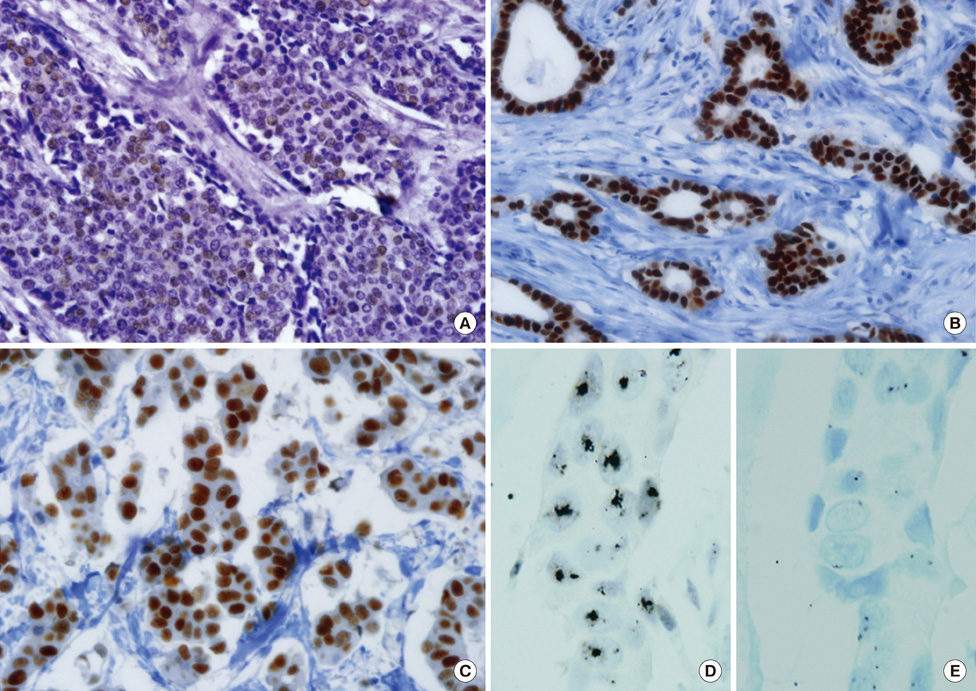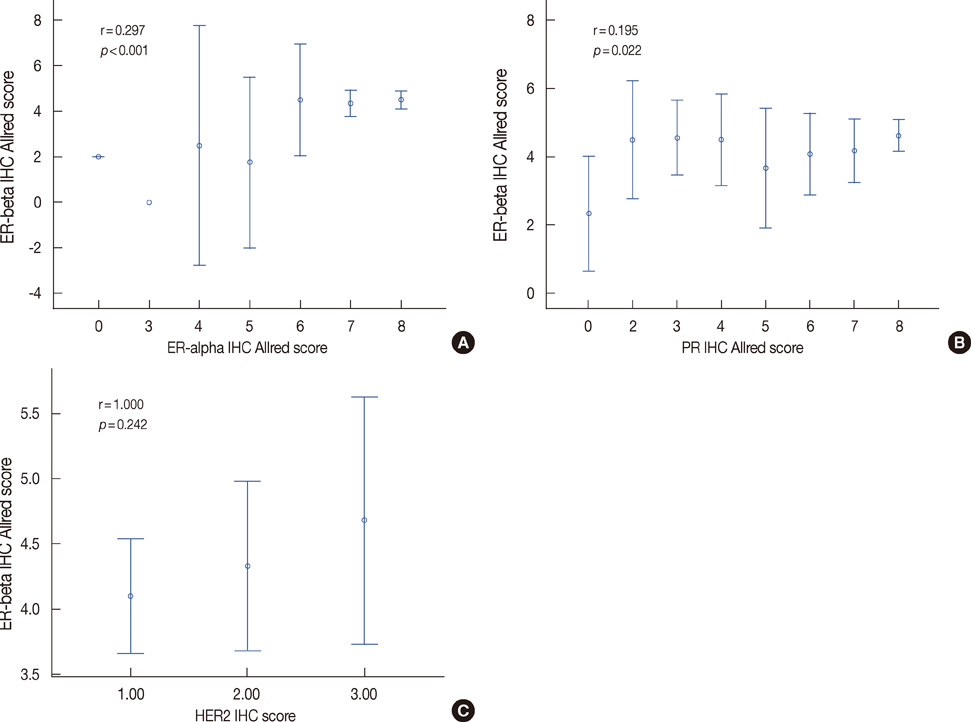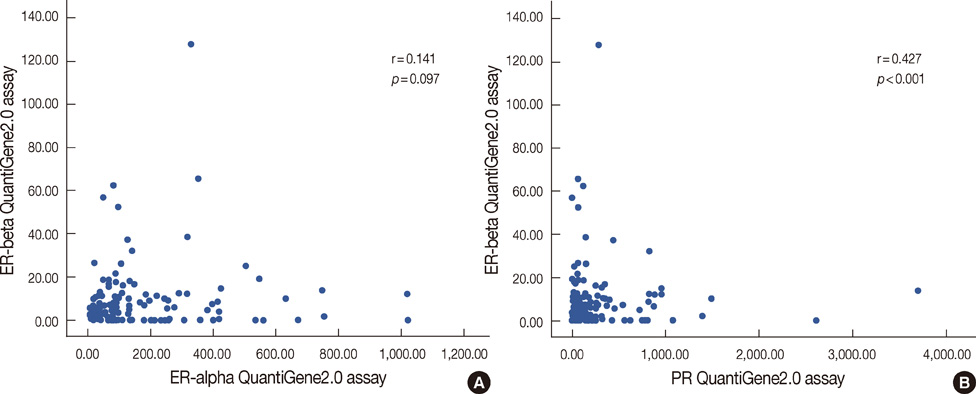J Breast Cancer.
2012 Mar;15(1):79-86. 10.4048/jbc.2012.15.1.79.
Prognostic Significance of High Expression of ER-beta in Surgically Treated ER-Positive Breast Cancer Following Endocrine Therapy
- Affiliations
-
- 1Department of Hospital Pathology, The Catholic University of Korea College of Medicine, Seoul, Korea. klee@catholic.ac.kr
- 2Department of Surgery, The Catholic University of Korea College of Medicine, Seoul, Korea.
- 3Department of Preventive Medicine, The Catholic University of Korea College of Medicine, Seoul, Korea.
- KMID: 2286477
- DOI: http://doi.org/10.4048/jbc.2012.15.1.79
Abstract
- PURPOSE
This study evaluated estrogen receptor (ER)-beta mRNA and ER-beta protein expression and its prognostic implications in hormone receptor-positive breast cancer.
METHODS
Paraffin sections from 139 hormone receptor-positive breast cancer cases were prepared. The expression of ER-beta mRNA and protein were analyzed by branched-chain assay and immunohistochemistry (IHC), respectively.
RESULTS
The Allred score of ER-beta IHC was correlated with smaller tumor size (p=0.043), the Allred score of ER-alpha IHC (p<0.001), and the Allred score of progesterone receptor (PR) IHC (p=0.022) but not with the HER2 IHC score. ER-beta mRNA level was correlated with PR mRNA levels (p<0.001) but not with the Allred score of ER-beta IHC, ER-alpha IHC, and PR IHC, nor with the HER2 IHC score and ER-alpha mRNA level. In survival analysis, high expression of ER-beta mRNA was associated with worse disease-free survival along with poor differentiation, lymph node metastasis and absence of PR protein expression in univariate analysis (p=0.040, p=0.002, p=0.018, and p=0.007, respectively) and multivariate analysis (p=0.044, p=0.002, p=0.035, and p=0.007, respectively).
CONCLUSION
High expression of ER-beta mRNA is an independent predictor of disease recurrence in hormone-receptor-positive breast cancer.
Keyword
MeSH Terms
Figure
Reference
-
1. Hurvitz SA, Pietras RJ. Rational management of endocrine resistance in breast cancer: a comprehensive review of estrogen receptor biology, treatment options, and future directions. Cancer. 2008. 113:2385–2397.
Article2. Osborne CK. Tamoxifen in the treatment of breast cancer. N Engl J Med. 1998. 339:1609–1618.
Article3. Iwase H, Zhang Z, Omoto Y, Sugiura H, Yamashita H, Toyama T, et al. Clinical significance of the expression of estrogen receptors alpha and beta for endocrine therapy of breast cancer. Cancer Chemother Pharmacol. 2003. 52:Suppl 1. S34–S38.4. Kuiper GG, Enmark E, Pelto-Huikko M, Nilsson S, Gustafsson JA. Cloning of a novel receptor expressed in rat prostate and ovary. Proc Natl Acad Sci U S A. 1996. 93:5925–5930.
Article5. Ogawa S, Inoue S, Watanabe T, Hiroi H, Orimo A, Hosoi T, et al. The complete primary structure of human estrogen receptor beta (hER beta) and its heterodimerization with ER alpha in vivo and in vitro. Biochem Biophys Res Commun. 1998. 243:122–126.
Article6. Vladusic EA, Hornby AE, Guerra-Vladusic FK, Lupu R. Expression of estrogen receptor beta messenger RNA variant in breast cancer. Cancer Res. 1998. 58:210–214.7. Saunders PT, Millar MR, Williams K, Macpherson S, Bayne C, O'Sullivan C, et al. Expression of oestrogen receptor beta (ERbeta1) protein in human breast cancer biopsies. Br J Cancer. 2002. 86:250–256.
Article8. Mann S, Laucirica R, Carlson N, Younes PS, Ali N, Younes A, et al. Estrogen receptor beta expression in invasive breast cancer. Hum Pathol. 2001. 32:113–118.
Article9. Chae BJ, Bae JS, Yim HW, Lee A, Song BJ, Jeon HM, et al. Measurement of ER and PR status in breast cancer using the QuantiGene2.0 assay. Pathology. 2011. 43:248–253.
Article10. Harvey JM, Clark GM, Osborne CK, Allred DC. Estrogen receptor status by immunohistochemistry is superior to the ligand-binding assay for predicting response to adjuvant endocrine therapy in breast cancer. J Clin Oncol. 1999. 17:1474–1481.
Article11. Wolff AC, Hammond ME, Schwartz JN, Hagerty KL, Allred DC, Cote RJ, et al. American Society of Clinical Oncology/College of American Pathologists guideline recommendations for human epidermal growth factor receptor 2 testing in breast cancer. Arch Pathol Lab Med. 2007. 131:18–43.
Article12. Yim HW, Song BJ, Jung SS, Kim HJ, Choi YJ, Lee KY, et al. Branched-chain assay for ER, PR, and HER2 RNA levels is a useful adjunct in the evaluation of ER, PR, and HER2 in breast cancer. J Breast Cancer. 2010. 13:267–274.
Article13. Russo J, Russo IH. The role of estrogen in the initiation of breast cancer. J Steroid Biochem Mol Biol. 2006. 102:89–96.
Article14. Knight WA, Livingston RB, Gregory EJ, McGuire WL. Estrogen receptor as an independent prognostic factor for early recurrence in breast cancer. Cancer Res. 1977. 37:4669–4671.15. Potemski P, Pluciennik E, Bednarek AK, Kusinska R, Kubiak R, Kordek R. Evaluation of oestrogen receptor expression in breast cancer by quantification of mRNA. Histopathology. 2007. 51:829–836.
Article16. Jarzabek K, Koda M, Kozlowski L, Mittre H, Sulkowski S, Kottler ML, et al. Distinct mRNA, protein expression patterns and distribution of oestrogen receptors alpha and beta in human primary breast cancer: correlation with proliferation marker Ki-67 and clinicopathological factors. Eur J Cancer. 2005. 41:2924–2934.
Article17. Saji S, Hirose M, Toi M. Clinical significance of estrogen receptor beta in breast cancer. Cancer Chemother Pharmacol. 2005. 56:Suppl 1. 21–26.
Article18. Rosa FE, Caldeira JR, Felipes J, Bertonha FB, Quevedo FC, Domingues MA, et al. Evaluation of estrogen receptor alpha and beta and progesterone receptor expression and correlation with clinicopathologic factors and proliferative marker Ki-67 in breast cancers. Hum Pathol. 2008. 39:720–730.
Article19. Myers E, Fleming FJ, Crotty TB, Kelly G, McDermott EW, O'Higgins NJ, et al. Inverse relationship between ER-beta and SRC-1 predicts outcome in endocrine-resistant breast cancer. Br J Cancer. 2004. 91:1687–1693.
Article20. Omoto Y, Kobayashi S, Inoue S, Ogawa S, Toyama T, Yamashita H, et al. Evaluation of oestrogen receptor beta wild-type and variant protein expression, and relationship with clinicopathological factors in breast cancers. Eur J Cancer. 2002. 38:380–386.
Article21. Nakopoulou L, Lazaris AC, Panayotopoulou EG, Giannopoulou I, Givalos N, Markaki S, et al. The favourable prognostic value of oestrogen receptor beta immunohistochemical expression in breast cancer. J Clin Pathol. 2004. 57:523–528.
Article22. Sugiura H, Toyama T, Hara Y, Zhang Z, Kobayashi S, Fujii Y, et al. Expression of estrogen receptor beta wild-type and its variant ERβcx/β2 is correlated with better prognosis in breast cancer. Jpn J Clin Oncol. 2007. 37:820–828.
Article23. Chang HG, Kim SJ, Chung KW, Noh DY, Kwon Y, Lee ES, et al. Tamoxifen-resistant breast cancers show less frequent methylation of the estrogen receptor beta but not the estrogen receptor alpha gene. J Mol Med (Berl). 2005. 83:132–139.
Article24. Speirs V, Malone C, Walton DS, Kerin MJ, Atkin SL. Increased expression of estrogen receptor beta mRNA in tamoxifen-resistant breast cancer patients. Cancer Res. 1999. 59:5421–5424.25. Markey GC, Cullen R, Diggin P, Hill AD, Mc Dermott EW, O'Higgins NJ, et al. Estrogen receptor-beta mRNA is associated with adverse outcome in patients with breast cancer. Tumour Biol. 2009. 30:171–175.
Article26. Leygue E, Dotzlaw H, Watson PH, Murphy LC. Expression of estrogen receptor beta1, beta2, and beta5 messenger RNAs in human breast tissue. Cancer Res. 1999. 59:1175–1179.27. Esslimani-Sahla M, Simony-Lafontaine J, Kramar A, Lavaill R, Mollevi C, Warner M, et al. Estrogen receptor beta (ER beta) level but not its ER beta cx variant helps to predict tamoxifen resistance in breast cancer. Clin Cancer Res. 2004. 10:5769–5776.
Article28. Murphy LC, Leygue E, Niu Y, Snell L, Ho SM, Watson PH. Relationship of coregulator and oestrogen receptor isoform expression to de novo tamoxifen resistance in human breast cancer. Br J Cancer. 2002. 87:1411–1416.
Article29. Nicholson RI, McClelland RA, Robertson JF, Gee JM. Involvement of steroid hormone and growth factor cross-talk in endocrine response in breast cancer. Endocr Relat Cancer. 1999. 6:373–387.
Article30. Torhorst J, Bucher C, Kononen J, Haas P, Zuber M, Köchli OR, et al. Tissue microarrays for rapid linking of molecular changes to clinical endpoints. Am J Pathol. 2001. 159:2249–2256.
Article
- Full Text Links
- Actions
-
Cited
- CITED
-
- Close
- Share
- Similar articles
-
- Comparison of estrogen receptor beta expression between breast cancer and normal mammary tissue and relationship with clinicopathological factors
- Characteristics and Prognosis of Estrogen Receptor Low-Positive Breast Cancer
- Current Understanding of Endocrine Therapy for Breast Cancer
- Expression of estrogen receptor beta, estrogen receptor alpha and cyclooxygenase II in advanced breast cancer
- The Prognostic Value of Epidermal Growth Factor Receptor in Primary Breast Cancer






